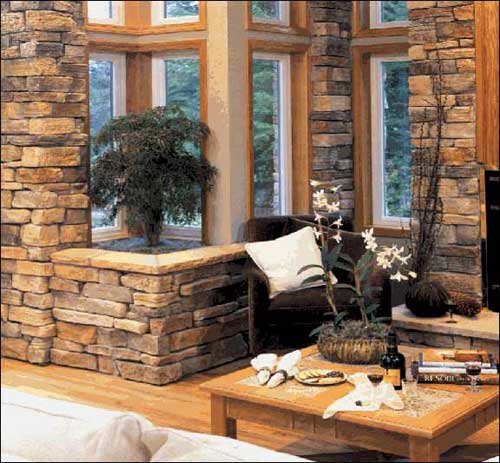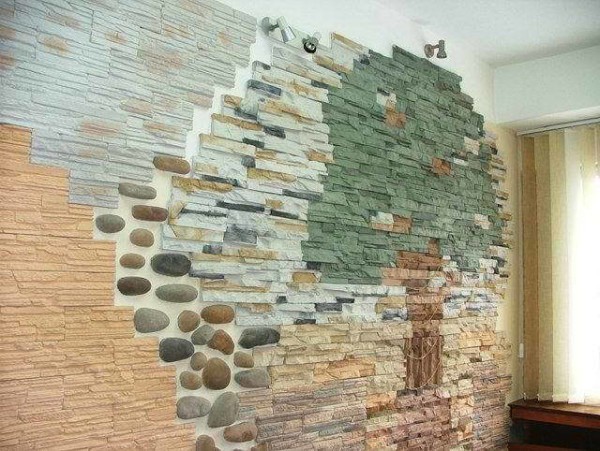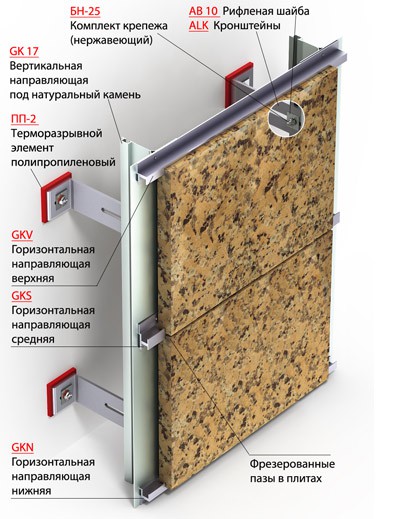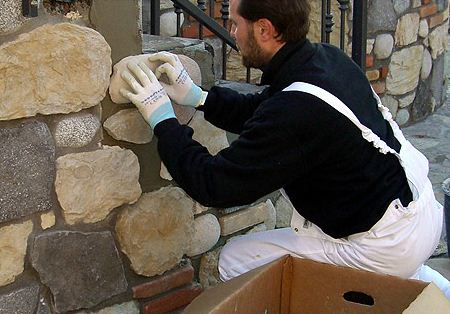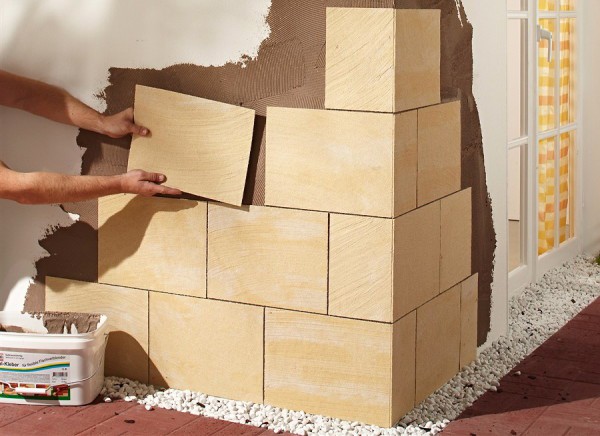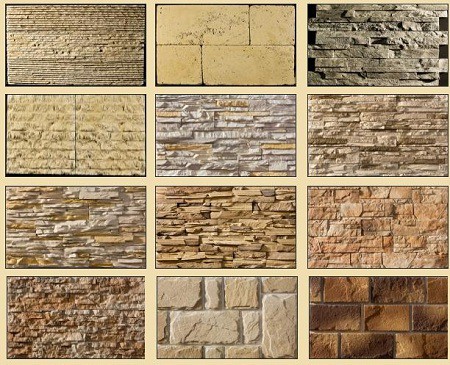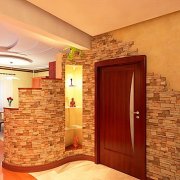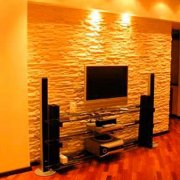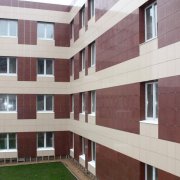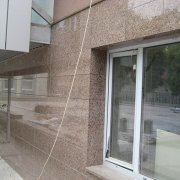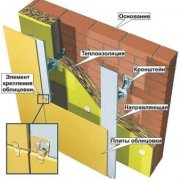Stone finish: types of material and application
Finishing work indoors and outdoors can be done with any modern materials. Despite this, stone trim has gained popularity, both in interior and exterior designs.
This happens for the reason that this way of design looks very beautiful and original.
The content of the article
Types of stones used in decorating
Today, natural and fake diamond. These types of material differ in their technical characteristics and properties.
In appearance, you will not immediately find differences, since decorative stone is very similar to natural.
Natural stones in decoration
Natural stone for decoration is quite popular.
The most commonly used types are:
- Marble.
- Granite.
- Sandstone.
- Limestone.
- Dagestan stone.
The photo shows an example of stones that are most often used in decorating.
Consider each view in detail:
- Marble. Very dense and practical agglomerate.
It has a large selection of colors. Used marble in kitchen decoration (countertops, bar counters).
Quite often, lately you can meet it as an ornament of the bottom of the wall. - Granite. This type of natural stone is the strongest and heaviest.
It is practical and durable. Like marble, it has a variety of shades and sizes. - Sandstone. The softest and easiest to use natural agglomerate.
It is porous and for this reason there is the possibility of cutting, sawing or performing any other actions. It looks very interesting, though it has not many shades. - Limestone. A soft natural stone, it is not recommended for external cladding, as it is exposed to weather conditions.
It is best used indoors where there is no high humidity.
Dagestan stone
This type of natural stone should be given special attention. Home decoration Dagestan stone over the past few years has become very fashionable.
Everything is due to the technical properties and characteristics of this agglomerate. It is considered a noble material, which is distinguished by its strength and durability.
Dagestan stone:
- Practical.
- Reliable.
- Easy to use.
- Does not absorb moisture.
- Frost resistant.
- Not subject to temperature changes.
- He will be able to withstand quite significant loads and not be deformed.
- It is used not only on the surface, but also on columns, arches and other decorative elements.
Note. Dagestan stone, unlike other stones, does not fonit, when how some can create a certain radiation background. That is, natural stone is a completely environmentally friendly material.
Decorating with stone slabs from Dagestan stone is very original and practical.
The benefits of natural stones
The main and main advantage natural stone is its environmental friendliness. All materials of this type are mined from rocks.
They are moisture resistant and cannot absorb a variety of contaminants. The latter does not apply to shell rock or sandstone, their surface is porous.
Material Features:
- The use of natural stone in decorating is considered a durable design, since the average life of such a material is at least 35-50 years.
- True, it is worth considering the region in which it is used. Very often on the surface of the agglomerate you can see the emergence of salt.
Tip. To prevent this from happening, the surface of natural stone must be treated with a special protective agent.
- Such actions must be carried out at least 1 time in 3 years, and even more often. Why does salt come out?
Everything is very simple, because of the high humidity, many types of natural agglomerates can be exposed to the environment. In this case, the texture of the stone, the finish is not deformed.
Also, stone of natural origin is not able to undergo temperature changes and climatic influences. Installing it is quite simple, but in some cases you can not do without special equipment.
Installation of natural stone
Natural stone in decoration, its characteristics are very different, as well as installation methods. Some types of natural agglomerates must be mounted on level surfaces (marble or granite slabs, sandstone or limestone), and some are installed without preparatory work on the surface.
In this case, the stone does not have direct shapes, but appears in the shape of a circle.
The order of work and the use of other materials:
- To mount such a stone, it is necessary to cut it into two halves so that they have at least one even plane. After that, a concrete mortar is applied to the wall and slightly natural stones go deep into it.
The process is quite quick and easy. - As for surface preparation, plaster or drywall is used in this process. With plaster, everything is clear, it can be starting and finishing.
- This product is produced in dry form and a liquid is added to the powder to obtain a solution. In order not to be mistaken with the proportions on the package, there is a certain instruction.
Tip. It should not be considered that the starting and finishing plasters can be interchangeable. Each of them should be used for its intended purpose (start - start of work, finish - end).
- With drywall everything is simpler, a special metal profile frame is mounted on the surface, on which sheets of material are installed. It is worth considering that in some cases, namely when installing natural stone, plaster is applied to the surface of the drywall to increase the strength of the finish.
Tip.
Since natural stone has a rather large mass, reinforcement must be made on the surface where it will be mounted. For this, a building reinforcement mesh is used, which is masked under a layer of plaster.
For the installation of natural stone you will need:
- Concrete mortar.
- Putty knife.
- Level (stone has straight proportions).
- Tile cutter (equipment for cutting tiles).
- Grinder (for sawing corners of the sinter, if necessary).
- Reinforcing mesh.
- Plaster.
Tip. If natural stone is used in finishing work on the floor, then the reinforcing mesh can not be used.
The full installation of natural stone is shown in the video.
Fake diamond
Artificial stone in its appearance resembles natural stone, only its price is several times lower than natural agglomerate.
Decorative stone is made from:
- Gypsum dough.
- Acrylic
- Synthetic fiber.
All these types have different technical properties and characteristics:
- Gypsum decorative stone can only be used indoors, as its surface, as a rule, is not covered with a protective film. It can quite easily absorb moisture and various contaminants.
You can only clean its surface with a damp rag without any abrasive products. - Acrylic decorative stone is also popular. It can be used both in internal and external finishing work.
It differs from the previous one in its strength and reliability. It is not able to absorb dirt and moisture, as its surface is protected by a coating. - Synthetic fibers are similar in their technical characteristics to acrylic decorative stones.
All stones of this type have a wide variety of shades and sizes. Decorative stone, texture, finish looks great and is in no way inferior to natural stone.
In addition to all of the above decorative stones, there is another type - a flexible decorative stone.
Flexible decorative stone
What is a flexible stone? Material is made from a thin layer of sandstone, which is treated with a binder.
The thickness of the flexible stone is not more than 3 mm. It can be in the form of wallpaper or individual adhesive plates.
Decorative trim with a flexible stone is very original.
Note. It is worth considering that the weight of such material is not more than 4-5 kg per 1 sq.m. It is glued very simply and even a delitant can cope with this process.
Flexible stone:
- Moisture resistant.
- Practical.
- Long-lasting (service life is 35 years).
- Easy to install.
- Frost resistant.
- Has a wide selection of shades.
- It does not fade.
- Not subject to weather and temperature changes.
The advantages of decorative stone
Any type of artificial stone has excellent technical characteristics. They are strong and durable.
It is worth considering their cost. That is, at an affordable price you can get high-quality and inexpensive finishes.
Decorating a room with decorative stone is quite popular.
So:
- All stones are not afraid of frost and temperature extremes. There are those types that are not recommended for use in rooms with high humidity (gypsum stone), and there are those that are widely used in exterior and interior decoration.
- You can use decorative stone on any building material. Quite often you can find aerated concrete trimmed with artificial stone.
Both that and that material practical and affordable.
It is worth considering that the installation of artificial stone must be carried out only on a prepared and flat surface. Unlike natural stone, artificial does not have a lot of weight and for this reason, reinforcing mesh to give strength in the decoration may not be used.
Mounting decorative stone
Decorating with a decorative stone with your own hands is quite possible. The whole process is pretty simple.
To do this, the surface must be well prepared (smooth and primed).
For installation you will need:
- Cement or adhesive mortar.
- Two spatulas.
- Level.
- The material itself.
- Decorative putty (if necessary).
In order not to use putty after installing the stone, you can add a coloring agent to the solution for fixing it, which gives a shade.
